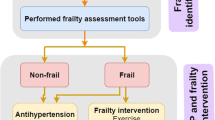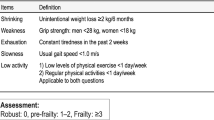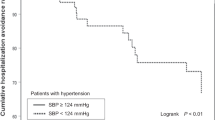Abstract
The significance of hypertension management in older individuals is greatly influenced by factors other than chronological age, as they have diverse physical, mental, and social backgrounds. Differences in physical functions, between independence, frailty and dependence, have a great impact on antihypertensive therapy in the older population. While recent clinical trials support the significance of intensive antihypertensive therapy regardless of age, there is little evidence to positively support the significance of antihypertensive therapy for older patients with physical function requiring nursing care, and observational studies suggest that antihypertensive treatment may instead be harmful in these older patients. Therefore, frailty, the transitional state between independence and dependence with the need for nursing care, is conceivable to be the tipping point at which the balance of risks and benefits of antihypertensive treatment is converted. The increased risk of acute adverse outcome is another issue that complicates management in the practice of hypertension treatment in frail patients. Particularly, increased blood pressure variability manifested by orthostatic hypotension in frail patients can induce fall and fracture leading to disability shortly after initiation or modification of antihypertensive treatment. Future challenges to optimize the management of frail hypertensive patients include developing techniques to estimate treatment efficacy, identifying safe antihypertensive regimens that reduce the risk of falls, and establishing strategies to restore frail patients to robust health.

This is a preview of subscription content, access via your institution
Access options
Subscribe to this journal
Receive 12 print issues and online access
$259.00 per year
only $21.58 per issue
Buy this article
- Purchase on Springer Link
- Instant access to full article PDF
Prices may be subject to local taxes which are calculated during checkout


Similar content being viewed by others
References
Geriatrics Evaluation & Management Tools. American Geriatrics Society. 2021.
Theou O, Walston J, Rockwood K. Operationalizing frailty using the frailty phenotype and deficit accumulation approaches. Interdiscip Top Gerontol Geriatr. 2015;41:66–73.
Woo J, Leung J, Morley JE. Comparison of frailty indicators based on clinical phenotype and the multiple deficit approach in predicting mortality and physical limitation. J Am Geriatr Soc. 2012;60:1478–86.
Hisamatsu T, Segawa H, Kadota A, Ohkubo T, Arima H, Miura K. Epidemiology of hypertension in Japan: beyond the new 2019 Japanese guidelines. Hypertens Res. 2020;43:1344–51.
Murayama H, Kobayashi E, Okamoto S, Fukaya T, Ishizaki T, Liang J, et al. National prevalence of frailty in the older Japanese population: findings from a nationally representative survey. Arch Gerontol Geriatr. 2020;91:104220.
Whelton PK, Carey RM, Aronow WS, Casey DE Jr, Collins KJ, Dennison Himmelfarb C, et al. 2017 ACC/AHA/AAPA/ABC/ACPM/AGS/APhA/ASH/ASPC/NMA/PCNA guideline for the prevention, detection, evaluation, and management of high blood pressure in adults: executive summary: a report of the American College of Cardiology/American Heart Association Task Force on Clinical Practice Guidelines. Hypertension. 2018;71:1269–324.
Unger T, Borghi C, Charchar F, Khan NA, Poulter NR, Prabhakaran D, et al. 2020 international society of hypertension global hypertension practice guidelines. Hypertension. 2020;75:1334–57.
Williams B, Mancia G, Spiering W, Agabiti Rosei E, Azizi M, Burnier M, et al. 2018 ESC/ESH guidelines for the management of arterial hypertension. Eur Heart J 2018;39:3021–104.
Umemura S, Arima H, Arima S, Asayama K, Dohi Y, Hirooka Y, et al. The Japanese Society of hypertension guidelines for the management of hypertension (JSH 2019). Hypertens Res. 2019;42:1235–481.
Group SR, Wright JT Jr, Williamson JD, Whelton PK, Snyder JK, Sink KM, et al. A randomized trial of intensive versus standard blood-pressure control. N. Engl J Med. 2015;373:2103–16.
Zhang W, Zhang S, Deng Y, Wu S, Ren J, Sun G, et al. Trial of intensive blood-pressure control in older patients with hypertension. N. Engl J Med. 2021;385:1268–79.
Williamson JD, Supiano MA, Applegate WB, Berlowitz DR, Campbell RC, Chertow GM, et al. Intensive vs standard blood pressure control and cardiovascular disease outcomes in adults aged >/=75 years: a randomized clinical trial. JAMA. 2016;315:2673–82.
Warwick J, Falaschetti E, Rockwood K, Mitnitski A, Thijs L, Beckett N, et al. No evidence that frailty modifies the positive impact of antihypertensive treatment in very elderly people: an investigation of the impact of frailty upon treatment effect in the HYpertension in the Very Elderly Trial (HYVET) study, a double-blind, placebo-controlled study of antihypertensives in people with hypertension aged 80 and over. BMC Med. 2015;13:78.
Todd OM, Wilkinson C, Hale M, Wong NL, Hall M, Sheppard JP, et al. Is the association between blood pressure and mortality in older adults different with frailty? A systematic review and meta-analysis. Age Ageing. 2019;48:627–35.
Inoue T, Matsuoka M, Shinjo T, Tamashiro M, Oba K, Kakazu M, et al. Blood pressure, frailty status, and all-cause mortality in elderly hypertensives; The Nambu Cohort Study. Hypertens Res. 2022;45:146–54.
Kremer KM, Braisch U, Rothenbacher D, Denkinger M, Dallmeier D, Acti FESG. Systolic blood pressure and mortality in community-dwelling older adults: frailty as an effect modifier. Hypertension. 2022;79:24–32.
Benetos A, Labat C, Rossignol P, Fay R, Rolland Y, Valbusa F, et al. Treatment with multiple blood pressure medications, achieved blood pressure, and mortality in older nursing home residents: the PARTAGE study. JAMA Intern Med. 2015;175:989–95.
Benetos A, Petrovic M, Strandberg T. Hypertension management in older and frail older patients. Circ Res. 2019;124:1045–60.
Sugimoto K, Yamamoto K. Hypertension, the decline of activities of daily living (ADL) and frailty. Hypertens Res. 2022;45:629–34.
Satake S, Arai H. The revised Japanese version of the Cardiovascular Health Study criteria (revised J-CHS criteria). Geriatr Gerontol Int. 2020;20:992–3.
Lawton MP, Brody EM. Assessment of older people: self-maintaining and instrumental activities of daily living. Gerontologist. 1969;9:179–86.
Mahoney FI, Barthel DW. Functional evaluation: the barthel index. Md State Med J. 1965;14:61–65.
O’Donoghue P, O’Halloran AM, Kenny RA, Romero-Ortuno R. Do the frail experience more adverse events from intensive blood pressure control? A 2-year prospective study in the Irish Longitudinal Study on Ageing (TILDA). EClinicalMedicine. 2022;45:101304.
Bromfield SG, Ngameni CA, Colantonio LD, Bowling CB, Shimbo D, Reynolds K, et al. Blood pressure, antihypertensive polypharmacy, frailty, and risk for serious fall injuries among older treated adults with hypertension. Hypertension. 2017;70:259–66.
Butt DA, Mamdani M, Austin PC, Tu K, Gomes T, Glazier RH. The risk of hip fracture after initiating antihypertensive drugs in the elderly. Arch Intern Med. 2012;172:1739–44.
Piotrowicz K, Gryglewska B, Grodzicki T, Gasowski J. Arterial stiffness and frailty - a systematic review and metaanalysis. Exp Gerontol. 2021;153:111480.
Luckey AE, Parsa CJ. Fluid and electrolytes in the aged. Arch Surg. 2003;138:1055–60.
Kocyigit SE, Soysal P, Bulut EA, Aydin AE, Dokuzlar O, Isik AT. What is the relationship between frailty and orthostatic hypotension in older adults? J Geriatr Cardiol. 2019;16:272–9.
Mol A, Slangen LRN, Trappenburg MC, Reijnierse EM, van Wezel RJA, Meskers CGM, et al. Blood pressure drop rate after standing up is associated with frailty and number of falls in geriatric outpatients. J Am Heart Assoc. 2020;9:e014688.
Ravindrarajah R, Hazra NC, Hamada S, Charlton J, Jackson SHD, Dregan A, et al. Systolic blood pressure trajectory, frailty, and all-cause mortality >80 years of age: cohort study using electronic health records. Circulation. 2017;135:2357–68.
Wang R, Vetrano DL, Liang Y, Qiu C. The age-related blood pressure trajectories from young-old adults to centenarians: a cohort study. Int J Cardiol. 2019;296:141–8.
Delgado J, Bowman K, Ble A, Masoli J, Han Y, Henley W, et al. Blood pressure trajectories in the 20 years before death. JAMA Intern Med. 2018;178:93–9.
Benetos A. How to obtain more evidence for the management of hypertension in frail patients over 80 years old? Eur Geriatr Med. 2018;9:137–40.
O’Connell ML, Coppinger T, McCarthy AL. The role of nutrition and physical activity in frailty: a review. Clin Nutr ESPEN. 2020;35:1–11.
Author information
Authors and Affiliations
Corresponding author
Ethics declarations
Conflict of interest
The author declares no competing interests.
Additional information
Publisher’s note Springer Nature remains neutral with regard to jurisdictional claims in published maps and institutional affiliations.
Rights and permissions
Springer Nature or its licensor (e.g. a society or other partner) holds exclusive rights to this article under a publishing agreement with the author(s) or other rightsholder(s); author self-archiving of the accepted manuscript version of this article is solely governed by the terms of such publishing agreement and applicable law.
About this article
Cite this article
Yamamoto, K. Current issues in frailty and hypertension management. Hypertens Res 46, 1917–1922 (2023). https://doi.org/10.1038/s41440-023-01310-1
Received:
Revised:
Accepted:
Published:
Issue Date:
DOI: https://doi.org/10.1038/s41440-023-01310-1



